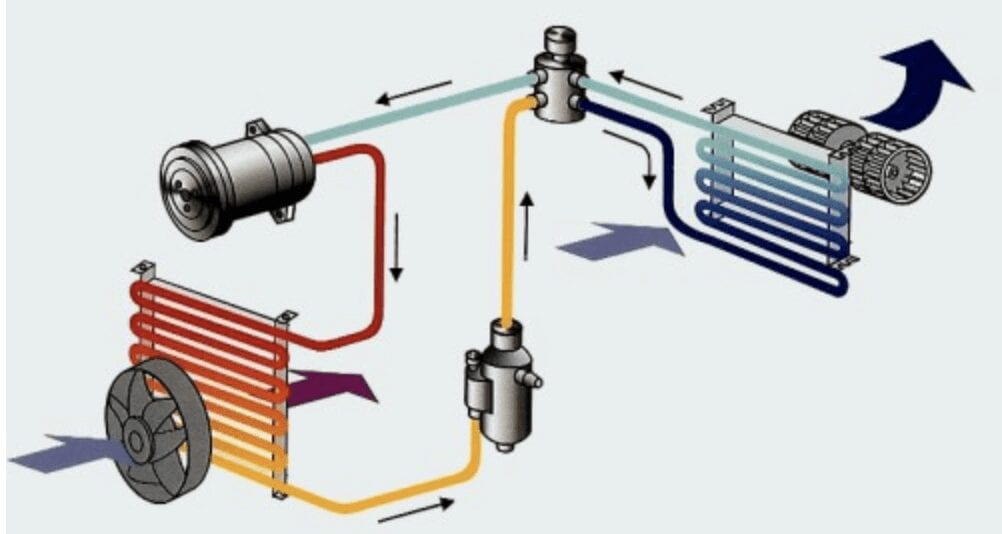
What is a car dual-circuit cooling system?
Content
Dual car cooling system
Dual cooling system. Some models of turbocharged gasoline engines use a dual circuit cooling system. One circuit provides engine cooling. Other cooling air for charging. The cooling circuits are independent of each other. But they have a connection and use a common expansion tank. The independence of the circuits allows you to maintain a different temperature of the coolant in each of them. The temperature difference can reach 100 ° C. Mix the coolant flow, do not let two check valves and throttles. The first circuit is the engine cooling system. The standard cooling system keeps the engine warm. In the range of 105 ° C Unlike the standard. In a dual-circuit cooling system, the temperature in the cylinder head is set in the range of 87 ° C. And in the cylinder block - 105 ° C. This is achieved through the use of two thermostats.
Dual circuit cooling system
This is mainly a dual-circuit cooling system. Since it is necessary to maintain a lower temperature in the cylinder head circuit, a larger volume of coolant circulates in it. About 2/3 of the total. The remaining coolant circulates in the cylinder block circuit. To ensure uniform cooling of the cylinder head, coolant circulates in it. In the direction from the exhaust manifold to the intake manifold. This design is called lateral cooling. Dual engine cooling system. The high intensity of the cylinder head cooling is accompanied by a high pressure cooler. This pressure is forced to overcome the thermostat upon opening. To facilitate the design of the cooling system. One of the thermostats is made with two-stage regulation.
Dual cooling system operation
The stove of such a thermostat consists of two interconnected parts. Small and big plate. First, a small plate opens, which raises a large plate. The operation of the cooling system is controlled by the engine management system. When the engine starts, both thermostats close. Provides quick warming up of the engine. The refrigerant circulates in a small circle around the cylinder head. From the pump through the cylinder head, heater heat exchanger, oil cooler and then into the expansion tank. This cycle is performed until the coolant temperature reaches 87 ° C. At a temperature of 87 ° C, the thermostat opens along the cylinder head. Coolant begins to circulate in a large circle. From the pump through the cylinder head. Heater, heat exchanger, oil cooler, open thermostat, radiator and then through the expansion tank.
At what temperature does the thermostat open
This cycle is carried out until the coolant in the cylinder block reaches 105°C. At 105°C, the thermostat opens the cylinder block circuit. The liquid begins to circulate in it. In this case, the temperature in the cylinder head circuit is always maintained at 87 ° C. The second circuit is the charge air cooling system. Scheme of the charge air cooling system. The charge air cooling system consists of a cooler, a radiator and a pump. that are connected by pipelines. The cooling system also contains a housing for the turbocharger bearings. The refrigerant in the circuit is circulated by a separate pump. Which is activated, if necessary, by a signal from the engine control unit. The fluid passing through the cooler removes heat from the charged air. Then it is cooled in the radiator.
Questions and answers:
What is included in the engine cooling system? This system consists of a motor cooling jacket, a hydraulic pump, a thermostat, connecting pipes, a radiator and a fan. Some cars use different additional devices.
How does a dual-circuit cooling system work? When the motor is in heating mode, the coolant circulates in a small circle. When the internal combustion engine reaches operating temperature, the thermostat opens and coolant circulates through the radiator in a large circle.
What is a dual-circuit cooling system for? After idle, the motor should quickly reach operating temperature, especially in cold weather. The large circulation circle ensures the cooling of the motor.
